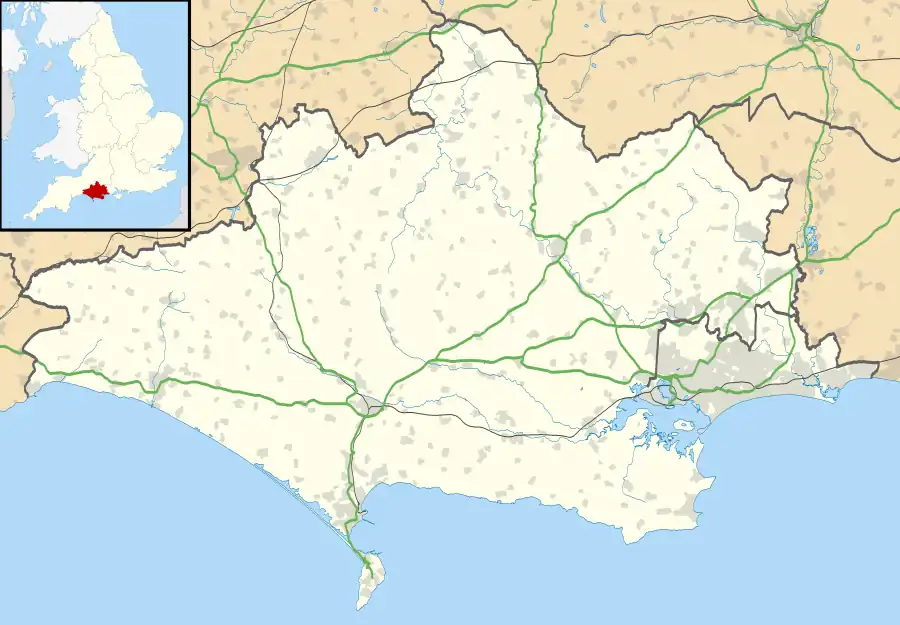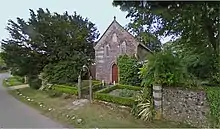| Ashmore | |
|---|---|
.JPG.webp) Ashmore village pond | |
 Ashmore Location within Dorset | |
| Population | 188 [1] |
| OS grid reference | ST912178 |
| • London | 116 mi (187 km) |
| Civil parish |
|
| District | |
| Shire county | |
| Region | |
| Country | England |
| Sovereign state | United Kingdom |
| Post town | Salisbury |
| Postcode district | SP5 |
| Dialling code | 01725 |
| Police | Dorset |
| Fire | Dorset and Wiltshire |
| Ambulance | South Western |
| UK Parliament | |

Ashmore is a village and civil parish in the North Dorset district of Dorset, England, 20 miles (32 kilometres) southwest of Salisbury.
The village is centred on a circular pond and has a church and several stone cottages and farms, many with thatched roofs. It is the highest village in the county with the 220-metre (720-foot) contour passing close to the village church (although the north side of the town of Shaftesbury, Dorset, is slightly higher at 232 m or 761 ft).[2]
The pond or "mere" gave the village its original name of "Ash-mere".[3]
In the 2011 census the parish had a population of 188.[1]
History
Three round barrows have been found in the parish: two barrows south of the village near Well Bottom, and one west of the village near the boundary with the village of Fontmell Magna; this latter barrow was excavated in the 19th century and bones were recovered.[4] Ashmore may have been the site of a Neolithic market place or settlement.[5]
The Roman road from Bath to Badbury Rings passes through the east of the parish.[4] The situation of the village is similar to Romano-British sites in the area,[4] and there may have been a military camp and trading post in the area.[5] It is possible that Ashmore may have been a Romano-British village that has been occupied without a break up to the present day; the parish church is sited West of the pond towards the edge of the village, which could indicate that the village pre-dated the church and Christianity.[6]
In 1086 Ashmore was recorded in the Domesday Book as "Aisemare";[7] it had 24 households, 7 ploughlands and 10 acres (4 hectares) of meadow. It was in Cranborne Hundred and had a value of £15 to the lord of the manor, who was King William.[8]
Until 1859 Ashmore had an open field system; the three fields—North Field to the north, and Sandpit Fields and Broadridge to the south—were roughly equal in size and covered an area of 380 acres (150 ha). At the same time there was also a considerable area of enclosed fields, covering 240 acres (97 ha) in 1590.[4]
Geography
Ashmore parish is situated on the hills of Cranborne Chase 4+1⁄2 mi (7 km) southeast of Shaftesbury and 7 mi (11 km) north of Blandford Forum. The underlying geology is chalk, overlain by clay-with-flints in the south and southeast.[4] The village, which at 700 ft (210 m) above sea level is the highest in Dorset,[9] is sited on a spur of land between dry valleys which drain south and southwest.[4] All of Ashmore parish is within the Cranborne Chase and West Wiltshire Downs Area of Outstanding Natural Beauty (AONB).[10]
The nearest rail link is 7 mi (11 km) from the village at Tisbury railway station and the nearest air link (Bournemouth International Airport) is 18 mi (29 km) away.


Church and Chapel
The parish church of St. Nicholas is about 100 metres west of the village pond, west of High Street. Its chancel arch is said to date from the 13th century and it was rebuilt in 1874.[11] On the opposite side of the High Street is a Wesleyan chapel which dates from 1855. [12]
Demography
In the 2011 census the parish had 97 dwellings,[13] 87 households and a population of 188.[1]
In the first national census in 1891 the village had a population of 228.[5]
Culture
In midsummer a celebration known as 'Filly Loo' (or 'Filleigh Loo'[14]) takes place around Ashmore pond, with a Green Man, country dancing, morris dancers and live music.[3][9][15] The event's ancient origins are mysterious but may have pagan influences;[16] theories include that it celebrated either the pond's constancy as a water supply,[9] the summer solstice,[15] or the end of the cultivated filbert (hazelnut) harvest.[5] The meaning of the name 'Filly Loo' has also attracted more than one explanation, including that it is West Country dialect for 'uproar',[16] a corruption of the French 'La Fille de l'Eau', ('maiden of the water'),[17] or a corruption of 'Filbert Louis', a nickname of Louis Rideout, one of the historical instigators of the event. The event was revived in 1956[14] as a folk dance festival, and takes place on the Friday night nearest to Midsummer Day or the Feast of St. John the Baptist.[17]
References
- 1 2 3 "Area: Ashmore (Parish), Key Figures for 2011 Census: Key Statistics". Neighbourhood Statistics. Office for National Statistics. Archived from the original on 11 October 2016. Retrieved 20 June 2014.
- ↑ "Street map". streetmap.co.uk. Retrieved 26 March 2023.
- 1 2 North Dorset District Council,North Dorset Official District Guide, Home Publishing Co. Ltd.,c.1983. p30
- 1 2 3 4 5 6 "'Ashmore', An Inventory of the Historical Monuments in Dorset, Volume 4: North (1972), pp. 1–3". British History Online. University of London & History of Parliament Trust. November 2013. Retrieved 20 June 2014.
- 1 2 3 4 "Ashmore Parish Plan 2006". Parish Plans. Dorset County Council. Retrieved 23 June 2014.
- ↑ Professor W G Hoskins (1955). The Making of the English Landscape. Book Club Associates. p. 52.
- ↑ "Dorset A–G". The Domesday Book Online. domesdaybook.co.uk. Retrieved 23 June 2014.
- ↑ "Place: Ashmore". Open Domesday. domesdaymap.co.uk. Archived from the original on 2 April 2015. Retrieved 23 June 2014.
- 1 2 3 Roland Gant (1980). Dorset Villages. Robert Hale Ltd. pp. 37–8. ISBN 0-7091-8135-3.
- ↑ "Cranborne Chase & West Wiltshire Downs Area of Outstanding Natural Beauty" (PDF). ccwwdaonb.org.uk. Archived from the original (PDF) on 8 August 2013. Retrieved 19 March 2015.
- ↑ "Ashmore village, Dorset - Walking Holidays in UK".
- ↑ "Ashmore".
- ↑ "Area: Ashmore (Parish), Dwellings, Household Spaces and Accommodation Type, 2011 (KS401EW)". Neighbourhood Statistics. Office for National Statistics. Retrieved 22 June 2014.
- 1 2 Ken Ayres (July 2012). "Ashmore – a photo essay". Dorset Life Magazine. Retrieved 20 June 2014.
- 1 2 Shappi Khorsandi (18 September 2006). "Filly Loo". Inside Out. BBC. Retrieved 20 June 2014.
- 1 2 Clive Aslet (2011). Villages of Britain: The Five Hundred Villages that Made the Countryside. Bloomsbury Publishing. ISBN 9781408817995. Retrieved 23 June 2014.
- 1 2 "Filly Loo". darkdorset.co.uk. Retrieved 24 June 2014.
- Pitt-Rivers, Michael, 1968. Dorset. London: Faber & Faber.
- Taylor, Christopher, 1970. The Making of the Dorset Landscape. London: Hodder & Stoughton.
External links
 Media related to Ashmore at Wikimedia Commons
Media related to Ashmore at Wikimedia Commons- The Dorset Page: Ashmore
